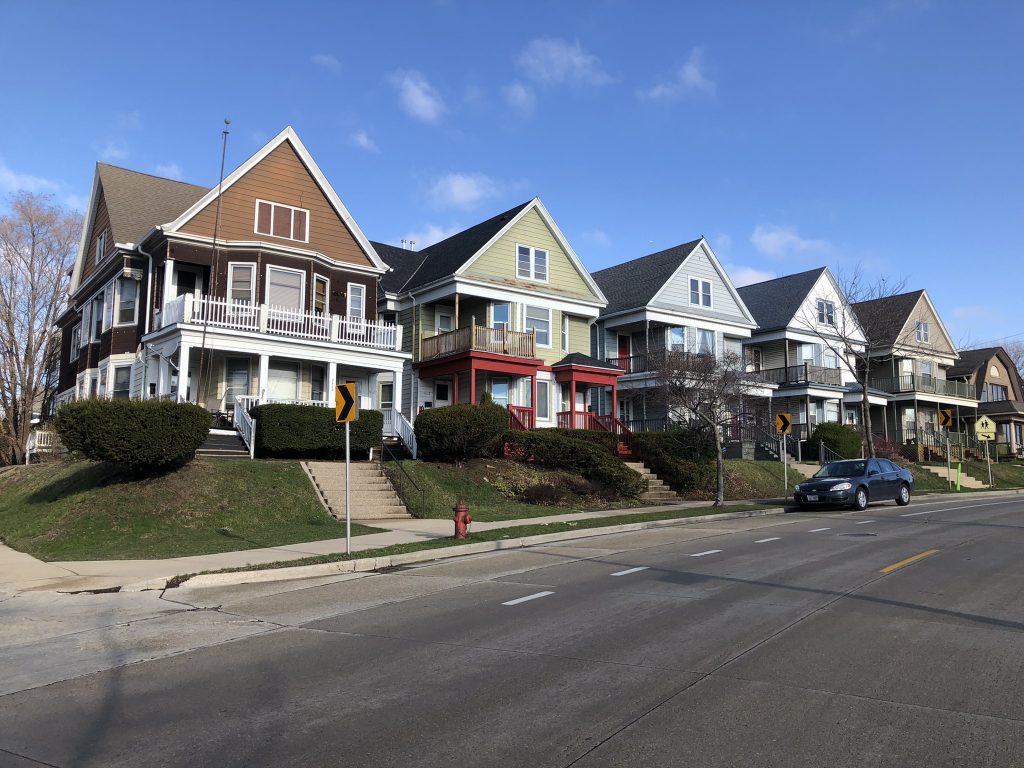Tight Housing Market Squeezing Out Poorest Renters
Even those with federal housing vouchers. Can Housing Division solve the problems?

Houses on S. Howell Ave. in Bay View. Photo by Jeramey Jannene.
Milwaukee’s incredibly tight rental market is squeezing out low-income renters and people facing homelessness.
The rental market has “dramatically changed,” in recent years, according to James Mathy, the Administrator of the Milwaukee County Housing Division. And the competition among renters for available units is making it harder for his division to place people using federal housing vouchers in apartments.
County policymakers have struggled trying to find a solution to housing voucher discrimination, which occurs when landlords and property managers turn away prospective renters who plan to pay their rent with the assistance of federal Section 8 housing vouchers.
The Housing Division has some ideas for how to help people using rental assistance have more success in finding housing. But it needs more funding.
In 2018, the Milwaukee County Board passed an ordinance banning housing voucher discrimination. It didn’t work.
The ban has failed for several reasons. First, it requires someone searching for housing to have a formal complaint notarized and filed with the county. As of 2023, zero complaints had been filed, but housing advocates have maintained that the problem persists. Second, the county’s own chief attorney, Corporation Counsel Margaret Daun, has called the county’s legal authority to enforce the ban “dubious.” And third, as Daun also noted, in order to enforce a ban the county would need to build out a government department complete with investigators and attorneys to focus on the problem, which did not occur when the legislation was passed in 2018.
Daun’s office is working up a formal legal opinion on enforcement of a housing voucher ban for the county board, as some supervisors don’t want to put down the stick before reaching for a carrot.
Sup. Shawn Rolland, chair of the board’s Committee on Health Equity, Human Needs and Strategic Planning, has proposed the county consider incentivizing landlords to accept Section 8 housing vouchers given the difficulty, legal and otherwise, the county has had with enforcement.
The Housing Division developed a report for the board sketching out some possible incentives the county could pursue to get more residents using housing vouchers into safe, stable rentals. While laying out the options during a meeting of the committee Wednesday, Mathy explained macroeconomic trends related to housing are also significantly impacting Section 8 renters.
Milwaukee has the third-lowest vacancy rate in the nation, the housing division reported, using data from CoStar Analytics. This means Section 8 renters, who already face voucher discrimination, are competing against renters without vouchers for the same units. It’s also producing a dramatic rise in rents. “So much that even our voucher programs can now be priced out of the market,” Mathy said.
The Housing Division does see opportunities for better incentivizing landlords to accept Section 8 housing vouchers. The U.S. Department of Housing and Urban Development, which administers the Section 8 program, states that one-time payments or additional funding available for damages or back-rent are effective strategies that have worked well in competitive markets like Milwaukee’s.
Section 8 vouchers work by guaranteeing eligible recipients they will not have to pay more than 30%-40% of their income toward rental payments. The difference is paid by the government. So the landlord is guaranteed these payments from the government, and by making the rent more affordable, there is a higher likelihood that the renter will be able to make their payments.
The Housing Division already operates a program that could be built out as a Section 8 incentive, according to the Housing Division. This is the Eviction Prevention Program, which can be used to pay back rent and late fees. The program does not have “adequate funding” right now, according to a report to the board by the Housing Division.
“Given that the Eviction Prevention Program is Milwaukee County’s most important landlord incentive for ensuring landlord satisfaction with rent assistance products, long-term funding for the Eviction Prevention Program is a primary priority for landlord financial incentives,” the Housing Division reported.
There is also a perception that Section 8 tenants cause more physical damage to properties than other renters and that the damage can lead to rental assistance being withheld when a unit fails inspection. “There is no data that suggests rent assistance households, on average, cause more physical damages,” the Housing Division said. A fund set up to pay for damages could mitigate some of this hesitation and be an incentive.
Another strategy would have the county lease a pool of rental units that can be passed from one rent assistance household to another. These Unit Holding Agreements, as they’re called, would be “especially helpful in a competitive rental market,” said Connor Goggins, senior real estate manager for the Housing Division.
Additional rental funding for incentives could also allow the Housing Division to work on “mass moving” events. This would entail partnering housing teams with landlords to directly target homeless shelters and encampments to swiftly connect people with the resources they need and housing to get them off the street.
“So really,” Goggins said, “what we’re trying to do is to see more rent assistance participation, more landlord participation, retainment of landlords, speedier housing process, more effective housing, navigation, increased housing stability, and, of course, improved satisfaction among those that work with our rent assistance.”
The Housing Division estimates it could roll out a package of these incentives and strategies for approximately $226,000 to $356,000 annually. It will be up to the board, as the county’s legislative branch, to decide on the funding.
If you think stories like this are important, become a member of Urban Milwaukee and help support real, independent journalism. Plus you get some cool added benefits.
MKE County
-
Ron Johnson Says Free-Market Principles Could Fix Education
 Jul 17th, 2024 by Graham Kilmer
Jul 17th, 2024 by Graham Kilmer
-
RNC Will Cause Some County Services To Be Moved to Wauwatosa
 Jul 12th, 2024 by Graham Kilmer
Jul 12th, 2024 by Graham Kilmer
-
Hank Aaron State Trail Will Be Closed For RNC, State Fair
 Jul 12th, 2024 by Graham Kilmer
Jul 12th, 2024 by Graham Kilmer






















Maybe restrict out of state purchases of housing. Oh, but then the free market would be upset., can’t have that! (We would much rather design a system of subsidies that props up the so called free market).
(from a Journal article in November)…
In 2005, out-of-state landlords owned about 5% of Milwaukee’s rental homes, according to an analysis by Marquette’s Johnson. ( Marquette University Law School research fellow John Johnson)
By spring 2021, that number had grown to 14%. Today, about 7,200 homes — or 18% — of all Milwaukee rental homes have out-of-state owners.
Investors from pricier cities “found it incredible that (homes in) a whole ZIP code — a whole part of the city of Milwaukee – could be purchased a few years ago for under $120,000,” said Graig Goldman, a longtime Milwaukee Realtor and CPA.
These slumlords *cough* out-of-state owners are draining money out of Milwaukee (both from the renters and the city itself, since their own spending obv won’t go back into the city).
It’s a double whammy.